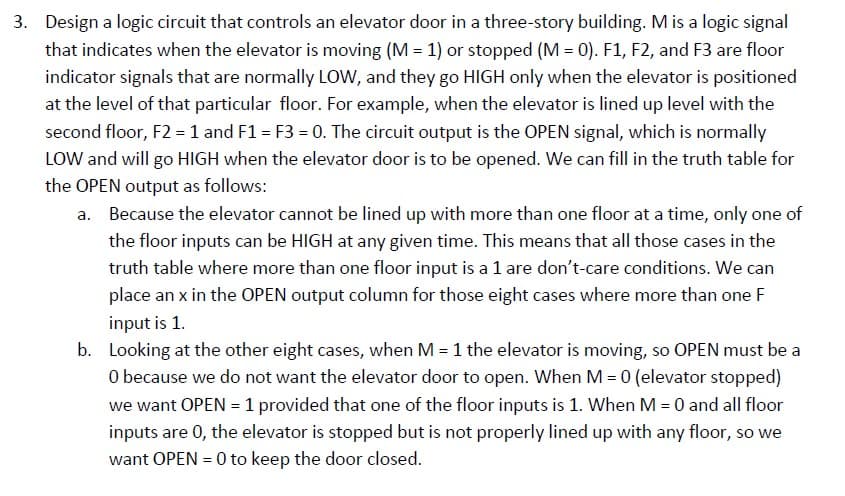Design a logic circuit that controls an elevator door in a three-story building. M is a logic signal that indicates when the elevator is moving (M = 1) or stopped (M = 0). F1, F2, and F3 are floor indicator signals that are normally LOW, and they go HIGH only when the elevator is positioned at the level of that particular floor. For example, when the elevator is lined up level with the second floor, F2 = 1 and F1 = F3 = 0. The circuit output is the OPEN signal, which is normally LOW and will go HIGH when the elevator door is to be opened. We can fill in the truth table for the OPEN output as follows: a. Because the elevator cannot be lined up with more than one floor at a time, only one o the floor inputs can be HIGH at any given time. This means that all those cases in the truth table where more than one floor input is a 1 are don't-care conditions. We can place an x in the OPEN output column for those eight cases where more than one F
Design a logic circuit that controls an elevator door in a three-story building. M is a logic signal that indicates when the elevator is moving (M = 1) or stopped (M = 0). F1, F2, and F3 are floor indicator signals that are normally LOW, and they go HIGH only when the elevator is positioned at the level of that particular floor. For example, when the elevator is lined up level with the second floor, F2 = 1 and F1 = F3 = 0. The circuit output is the OPEN signal, which is normally LOW and will go HIGH when the elevator door is to be opened. We can fill in the truth table for the OPEN output as follows: a. Because the elevator cannot be lined up with more than one floor at a time, only one o the floor inputs can be HIGH at any given time. This means that all those cases in the truth table where more than one floor input is a 1 are don't-care conditions. We can place an x in the OPEN output column for those eight cases where more than one F
Computer Networking: A Top-Down Approach (7th Edition)
7th Edition
ISBN:9780133594140
Author:James Kurose, Keith Ross
Publisher:James Kurose, Keith Ross
Chapter1: Computer Networks And The Internet
Section: Chapter Questions
Problem R1RQ: What is the difference between a host and an end system? List several different types of end...
Related questions
Question
100%

Transcribed Image Text:3. Design a logic circuit that controls an elevator door in a three-story building. M is a logic signal
that indicates when the elevator is moving (M = 1) or stopped (M = 0). F1, F2, and F3 are floor
indicator signals that are normally LOW, and they go HIGH only when the elevator is positioned
at the level of that particular floor. For example, when the elevator is lined up level with the
second floor, F2 = 1 and F1 = F3 = 0. The circuit output is the OPEN signal, which is normally
LOW and will go HIGH when the elevator door is to be opened. We can fill in the truth table for
the OPEN output as follows:
a. Because the elevator cannot be lined up with more than one floor at a time, only one of
the floor inputs can be HIGH at any given time. This means that all those cases in the
truth table where more than one floor input is a 1 are don't-care conditions. We can
place an x in the OPEN output column for those eight cases where more than one F
input is 1.
b. Looking at the other eight cases, when M = 1 the elevator is moving, so OPEN must be a
O because we do not want the elevator door to open. When M = 0 (elevator stopped)
we want OPEN = 1 provided that one of the floor inputs is 1. When M = 0 and all floor
inputs are 0, the elevator is stopped but is not properly lined up with any floor, so we
want OPEN = 0 to keep the door closed.
Expert Solution
This question has been solved!
Explore an expertly crafted, step-by-step solution for a thorough understanding of key concepts.
This is a popular solution!
Trending now
This is a popular solution!
Step by step
Solved in 2 steps with 3 images

Recommended textbooks for you

Computer Networking: A Top-Down Approach (7th Edi…
Computer Engineering
ISBN:
9780133594140
Author:
James Kurose, Keith Ross
Publisher:
PEARSON

Computer Organization and Design MIPS Edition, Fi…
Computer Engineering
ISBN:
9780124077263
Author:
David A. Patterson, John L. Hennessy
Publisher:
Elsevier Science

Network+ Guide to Networks (MindTap Course List)
Computer Engineering
ISBN:
9781337569330
Author:
Jill West, Tamara Dean, Jean Andrews
Publisher:
Cengage Learning

Computer Networking: A Top-Down Approach (7th Edi…
Computer Engineering
ISBN:
9780133594140
Author:
James Kurose, Keith Ross
Publisher:
PEARSON

Computer Organization and Design MIPS Edition, Fi…
Computer Engineering
ISBN:
9780124077263
Author:
David A. Patterson, John L. Hennessy
Publisher:
Elsevier Science

Network+ Guide to Networks (MindTap Course List)
Computer Engineering
ISBN:
9781337569330
Author:
Jill West, Tamara Dean, Jean Andrews
Publisher:
Cengage Learning

Concepts of Database Management
Computer Engineering
ISBN:
9781337093422
Author:
Joy L. Starks, Philip J. Pratt, Mary Z. Last
Publisher:
Cengage Learning

Prelude to Programming
Computer Engineering
ISBN:
9780133750423
Author:
VENIT, Stewart
Publisher:
Pearson Education

Sc Business Data Communications and Networking, T…
Computer Engineering
ISBN:
9781119368830
Author:
FITZGERALD
Publisher:
WILEY